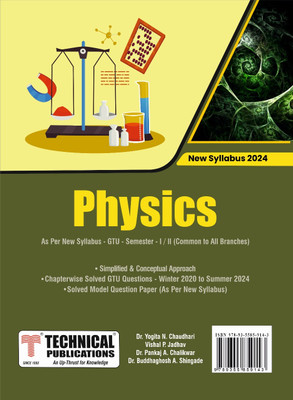Physics for GTU 24 Course (I/II- COMMON)(Paperback, Dr. Yogita N. Chaudhari, Vishal P. Jadhav, Dr. Pankaj A. Chalikwar, Dr. Buddhaghosh A. Shingade)
Quick Overview
Product Price Comparison
SyllabusPhysicsTotal Credits L+T+ (PR/2)Assessment Pattern and MarksTotal MarksCTheoryTutorial / PracticalESE(E)PA/CA(M)PA/CA (I)ESE(V)470302030150Unit No.Content1.PROPERTIES OF MATTERŌĆóStress - Strain - HookeŌĆÖs law.ŌĆóElastic Behaviour of Material.ŌĆóYoungŌĆÖs modulus by cantilever depression.ŌĆóNon-uniform bending.ŌĆóUniform bending.ŌĆóApplication - I - shaped girders.ŌĆóTorsional Pendulum - Couple per unit twist of a wire, Time period.ŌĆóApplication - Determination of Rigidity Modulus. (Chapter - 1)2.WAVES, MOTION AND ACOUSTICSŌĆóSimple Harmonic motion, Free, forced, Resonance.ŌĆóDamped and undamped vibration.ŌĆóDamped harmonic motion.ŌĆóForce vibration and amplitude resonance.ŌĆóVelocity resonance and energy intake.ŌĆóWave motion, transverse and longitudinal vibration.ŌĆóSound absorption and reverberation.ŌĆóSabine's formula and usage (excluding derivation).ŌĆóAcoustic of building.ŌĆóUltrasonic waves - Properties - Generation - Piezoelectric method - Detection - KundtŌĆÖs tube.ŌĆóApplication of Ultrasonics in industries - NDT. (Chapter - 2)3.OPTICSŌĆóHuygens' Principle : Fundamental principle for wave propagation.ŌĆóSuperposition of Waves : Basic principle for understanding interference and diffraction.ŌĆóExplanation of constructive and destructive interference.ŌĆóApplications in thin film interference, such as soap bubbles and oil films.ŌĆóYoungŌĆÖs double slit experiment.ŌĆóNewtonŌĆÖs rings.ŌĆóMichelson Interferometer.ŌĆóAnti-reflection coating.ŌĆóFresnel and Fraunhofer diffraction - diffraction due to ŌĆśnŌĆÖ slits- plane transmission grating.ŌĆóRayleigh criterion for limit of resolution - resolving power of grating. (Chapter - 3)4.QUANTUM PHYSICSŌĆóBlack body Radiation-PlanckŌĆÖs law.ŌĆóEnergy distribution function.ŌĆóWave-particle duality-de Broglie matter waves.ŌĆóConcept of the wave function and its physical significance - HeisenbergŌĆÖs Uncertainty Principle.ŌĆóSchrodingerŌĆÖs wave equation - Time-independent and Time -dependent equations.ŌĆóParticle in a one-dimensional rigid box - tunneling (Qualitative) - Scanning Tunnelling Microscope. (Chapter - 4)5.LASERSŌĆóProperties of Laser, EinsteinŌĆÖs theory of matter radiation : A and B coefficients.ŌĆóAmplification of light by population inversion.ŌĆóDifferent types of lasers.ŌĆóGas lasers (He-Ne).ŌĆóSolid-state lasers (Ruby laser).ŌĆóProperties of laser beams : Mono-chromaticity, coherence, directionality and brightness, laser speckles.ŌĆóApplications of lasers in science, engineering and medicine. (Chapter - 5)6.NEW ENGINEERING MATERIALSSEMICONDUCTOR MATERIALS :ŌĆóIntroduction of Group IV elements.ŌĆóProperties.ŌĆóConcept of carriers.ŌĆóConcept of bands and band gap.ŌĆóP-type, N-type materials.ŌĆóIntroduction to P-N Junction Diode and I-V characteristics.ŌĆóZener diode and its characteristics.SUPERCONDUCTING MATERIALS :ŌĆóIntroduction - Properties.ŌĆóMeissner effect.ŌĆóType I & Type II superconductors.ŌĆóApplications.NANOMATERIALS :ŌĆóIntroduction.ŌĆóSynthesis of nano materials - Top down and Bottom up approachŌĆóBall milling.ŌĆóPVD method.ŌĆóApplications. (Chapter - 6)


